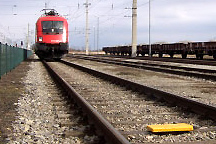Wednesday 11 June, 2014, 09:00 - Spectrum Management
Posted by Administrator
You would have thought that those designing systems that use the radio spectrum would check that the frequencies they planned to use would not cause interference to other systems and equally importantly that they would not suffer interference from other users. Such basic compatibility checks are critical to ensure that different communication systems can inter-operate successfully. So it is a bit of a surprise to find that the designers of the Eurobalise, a technology that forms part of the European Rail Traffic Management System and whose purpose is to assist in the control of train movements (to control their movement and help them know where they are) has chosen a frequency which fails these simple safeguards.Posted by Administrator

Where they have gone wrong is to use a frequency for transferring information between the Eurobalise and the train that is in a European broadcast band!
 The Eurobalise uplink operates on a centre frequency of 4234 kHz, with a frequency deviation of +/- 282 kHz. This means that a logic '1' is sent on a frequency of 4516 kHz and a logic '0' is sent on a frequency of 3952 kHz (source: Mermec Eurobalise specification). Interfering signals on, or near, frequencies of 3952 or 4516 kHz would cause the most trouble, but as the Balise's receiver is listening across the whole range 3952 to 4516 kHz, any transmission in this range would cause a problem. The (European) 75 metre broadcast band runs from 3950 to 4000 kHz. Any broadcasts in the 75 meter band could therefore cause a problem to nearby trains, but those on frequencies from approximately 3950 to 3955 kHz will have the greatest potential to interfere with the Balise's operation.
The Eurobalise uplink operates on a centre frequency of 4234 kHz, with a frequency deviation of +/- 282 kHz. This means that a logic '1' is sent on a frequency of 4516 kHz and a logic '0' is sent on a frequency of 3952 kHz (source: Mermec Eurobalise specification). Interfering signals on, or near, frequencies of 3952 or 4516 kHz would cause the most trouble, but as the Balise's receiver is listening across the whole range 3952 to 4516 kHz, any transmission in this range would cause a problem. The (European) 75 metre broadcast band runs from 3950 to 4000 kHz. Any broadcasts in the 75 meter band could therefore cause a problem to nearby trains, but those on frequencies from approximately 3950 to 3955 kHz will have the greatest potential to interfere with the Balise's operation. Do any such transmissions exist? According to short-wave.info, the BBC and Korean broadcaster KBC use a frequency of 3955 kHz on a daily basis, from the BBC's transmitter at Woofferton, Shropshire. If you click on the link (which will take you to Google maps) you will notice that running alongside the village of Woofferton is a grey line - a railway!
But surely fears of interference are unfounded and just another example of scare tactics by spectrum managers bent on safeguarding their highly paid jobs. Sadly not... It appears that the transmissions from Woofferton have been disrupting trains between Leominster and Ludlow! According to the article in the Hereford Times, Network Rail, the organisation responsible for operating the rail infrastructure in the UK, claim:
while the interference does not pose a risk to the safe operation of the railway, it has been stopping trains en-route.
Oops!
 The only other high power transmitter in this band in Europe is at Issoudun in central France. A quick check of Google maps shows that there are no train tracks in the immediate vicinity. There is a transmitter in Kall-Krekel in north west Germany which also uses frequencies in the 75 metre broadcasting band that could also cause interference to Eurobalises, but that transmitter uses much lower power than those at Woofferton or Issoudun.
The only other high power transmitter in this band in Europe is at Issoudun in central France. A quick check of Google maps shows that there are no train tracks in the immediate vicinity. There is a transmitter in Kall-Krekel in north west Germany which also uses frequencies in the 75 metre broadcasting band that could also cause interference to Eurobalises, but that transmitter uses much lower power than those at Woofferton or Issoudun.Maybe, given that there is only one potential location where the choice of frequency, and proximity to a broadcast transmitter, could be a problem, the designers did do their homework after all and decided that it was alright for occasional problems to arise. Maybe. Then again, the other frequencies used by the Eurobalise include a military band and the middle of the 27 MHz Citizens Band!
add comment
( 852 views )
| permalink
| 



 ( 2.9 / 1660 )
( 2.9 / 1660 )




 ( 2.9 / 1660 )
( 2.9 / 1660 )

